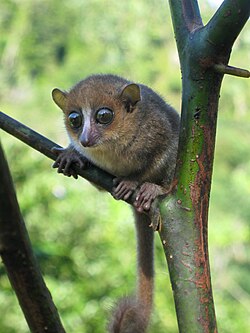Portal:Primates
The Primates Portal A primate is a member of the biological order Primates, the group that contains lemurs, the aye-aye, lorisids, galagos, tarsiers, monkeys, and apes, with the last category including great apes. With the exception of humans, who inhabit every continent on Earth, most primates live in tropical or subtropical regions of the Americas, Africa and Asia. Primates range in size from the 30-gram (1 oz) pygmy mouse lemur to the 200-kilogram (440 lb) mountain gorilla. According to fossil evidence, the primitive ancestors of primates may have existed in the late Cretaceous period around 65 mya (million years ago), and the oldest known primate is the Late Paleocene Plesiadapis, c. 55–58 mya. Molecular clock studies suggest that the primate branch may be even older, originating in the mid-Cretaceous period around 85 mya. Primates exhibit a wide range of characteristics. Some primates do not live primarily in trees, but all species possess adaptations for climbing trees. Locomotion techniques used include leaping from tree to tree, walking on two or four limbs, knuckle-walking, and swinging between branches of trees (known as brachiation). Primates are characterized by their large brains relative to other mammals. These features are most significant in monkeys and apes, and noticeably less so in lorises and lemurs. Many species are sexually dimorphic, which means males and females have different physical traits, including body mass, canine tooth size, and coloration.
Selected articleLemurs of Madagascar, currently in its third edition, is a reference work and field guide for the lemurs of Madagascar, giving descriptions and biogeographic data for the known species. The primary contributor is Russell Mittermeier, president of Conservation International, and the cover art and illustrations were drawn by Stephen D. Nash. The book provides details about all known lemur species, general information about lemurs and their history, and also helps travelers identify species they may encounter. Four related pocket field guides have also been released, containing color illustrations of each species, miniature range maps, and species checklists. The first edition was reviewed favorably in the International Journal of Primatology, Conservation Biology, and Lemur News. Reviewers, including Alison Jolly, praised the book for its meticulous coverage of each species, numerous high-quality illustrations, and engaging discussion of lemur topics, including conservation, evolution, and the recently extinct subfossil lemurs. Each agreed that the book was an excellent resource for a wide audience, including ecotourists and lemur researchers. A lengthy review of the second edition was published in the American Journal of Primatology, where it received similar favorable comments, plus praise for its updates and enhancements. The third edition was reviewed favorably in Lemur News; the reviewer praised the expanded content of the book, but was concerned that the edition was not as portable as its predecessors. The first edition identified 50 lemur species and subspecies, compared to 71 in the second edition and 101 in the third. The taxonomy promoted by these books has been questioned by researchers, such as Ian Tattersall, who view these growing numbers of lemur species as insufficiently justified inflation of species numbers (taxonomic inflation). Selected picture The white-fronted capuchin, Cebus albifrons, is a species of capuchin monkey, a type of New World primate, found in seven different countries in South America: Bolivia, Brazil, Colombia, Venezuela, Ecuador, Peru, and Trinidad and Tobago. The species is divided into several different subspecies, though the specific divisions are uncertain and controversial. CategoriesSelected species Critically Endangered (IUCN 3.1)|Critically endangered Gerp's mouse lemur (Microcebus gerpi) is a species of mouse lemur known only from the Sahafina forest in eastern Madagascar, near Mantadia National Park. Its discovery was announced in 2012 by a German and Malagasy research team. Based on genetic studies, measurements, and photos, the research team confirmed that Gerp's mouse lemur was an undescribed species, distinct from Goodman's mouse lemur, which is found 58 kilometers (36 mi) away. Gerp's mouse lemur is significantly larger, weighing on average 68 grams (2.4 oz), compared to Goodman's mouse lemur, which weighs approximately 44 g (1.6 oz). Jolly's mouse lemur, which is its closest relative and a neighbor to the south, is comparably large, but differs in tail length and genetics. Because it is a recently discovered species, nothing is known about its behavior, communication, ecology, or reproduction. The species appears to be restricted to a small region of lowland evergreen rain forest, and is seriously threatened by forest loss. Did you know?
Primate lists
WikiProjectsThings to do
Associated WikimediaDiscover Wikipedia using portals |
















